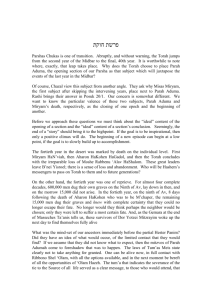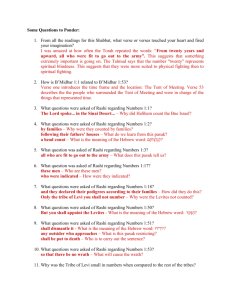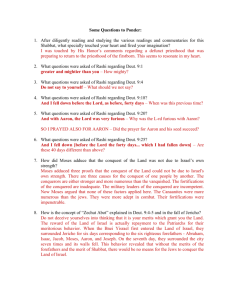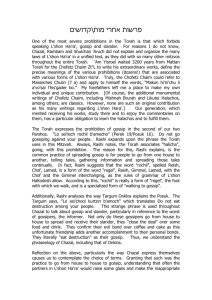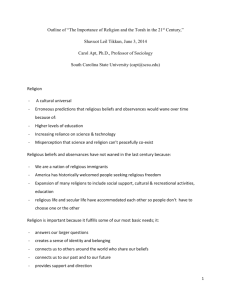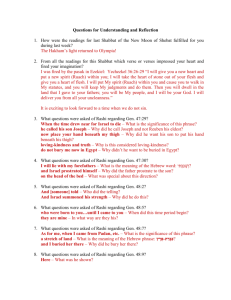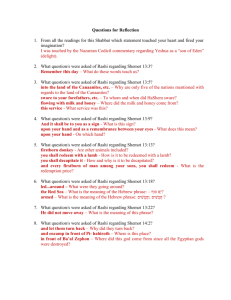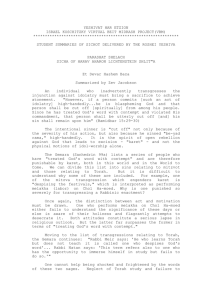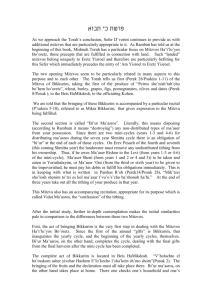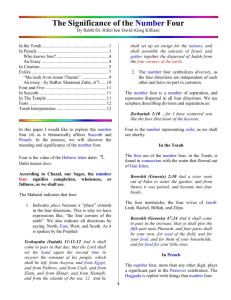Parshas B`reishis
advertisement
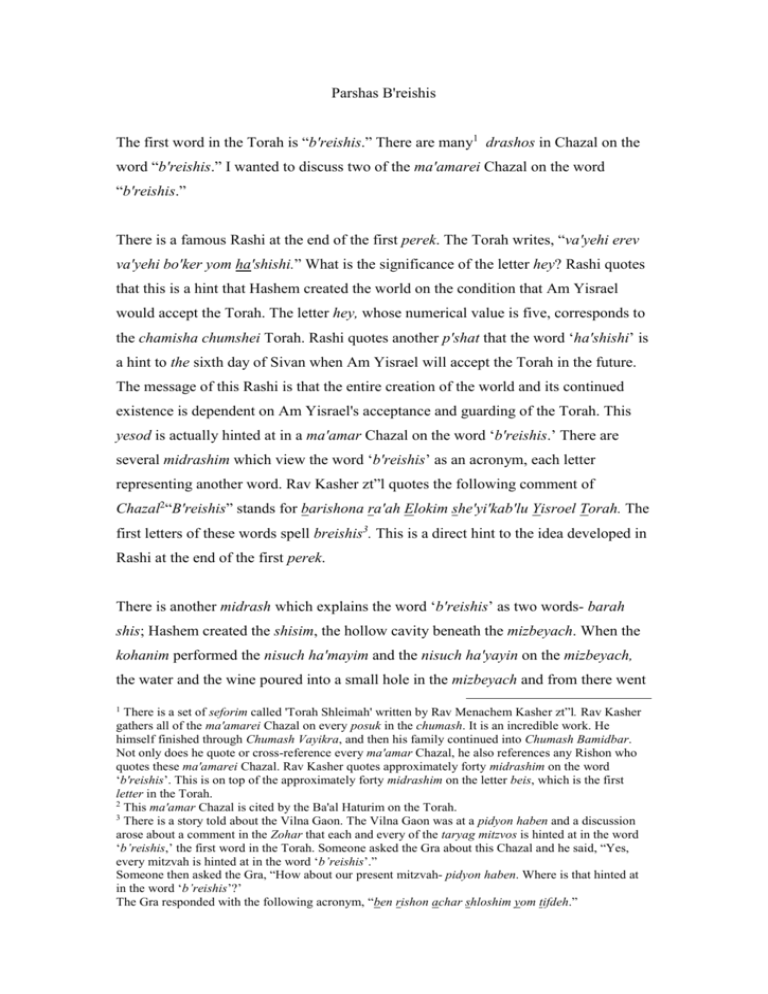
Parshas B'reishis The first word in the Torah is “b'reishis.” There are many1 drashos in Chazal on the word “b'reishis.” I wanted to discuss two of the ma'amarei Chazal on the word “b'reishis.” There is a famous Rashi at the end of the first perek. The Torah writes, “va'yehi erev va'yehi bo'ker yom ha'shishi.” What is the significance of the letter hey? Rashi quotes that this is a hint that Hashem created the world on the condition that Am Yisrael would accept the Torah. The letter hey, whose numerical value is five, corresponds to the chamisha chumshei Torah. Rashi quotes another p'shat that the word ‘ha'shishi’ is a hint to the sixth day of Sivan when Am Yisrael will accept the Torah in the future. The message of this Rashi is that the entire creation of the world and its continued existence is dependent on Am Yisrael's acceptance and guarding of the Torah. This yesod is actually hinted at in a ma'amar Chazal on the word ‘b'reishis.’ There are several midrashim which view the word ‘b'reishis’ as an acronym, each letter representing another word. Rav Kasher zt”l quotes the following comment of Chazal2“B'reishis” stands for barishona ra'ah Elokim she'yi'kab'lu Yisroel Torah. The first letters of these words spell breishis3. This is a direct hint to the idea developed in Rashi at the end of the first perek. There is another midrash which explains the word ‘b'reishis’ as two words- barah shis; Hashem created the shisim, the hollow cavity beneath the mizbeyach. When the kohanim performed the nisuch ha'mayim and the nisuch ha'yayin on the mizbeyach, the water and the wine poured into a small hole in the mizbeyach and from there went There is a set of seforim called 'Torah Shleimah' written by Rav Menachem Kasher zt”l. Rav Kasher gathers all of the ma'amarei Chazal on every posuk in the chumash. It is an incredible work. He himself finished through Chumash Vayikra, and then his family continued into Chumash Bamidbar. Not only does he quote or cross-reference every ma'amar Chazal, he also references any Rishon who quotes these ma'amarei Chazal. Rav Kasher quotes approximately forty midrashim on the word ‘b'reishis’. This is on top of the approximately forty midrashim on the letter beis, which is the first letter in the Torah. 2 This ma'amar Chazal is cited by the Ba'al Haturim on the Torah. 3 There is a story told about the Vilna Gaon. The Vilna Gaon was at a pidyon haben and a discussion arose about a comment in the Zohar that each and every of the taryag mitzvos is hinted at in the word ‘b’reishis,’ the first word in the Torah. Someone asked the Gra about this Chazal and he said, “Yes, every mitzvah is hinted at in the word ‘b’reishis’.” Someone then asked the Gra, “How about our present mitzvah- pidyon haben. Where is that hinted at in the word ‘b’reishis’?’ The Gra responded with the following acronym, “ben rishon achar shloshim yom tifdeh.” 1 down into the shisim, a deep cavity under the mizbeyach. The midrash says that Hashem created this cavity at the time of ma'aseh b'reishis- barah shis4. Since, as Chazal say, this cavity was created at the time of b'reishis it must be very significant. What is the symbolism of the hole, this open space, under the mizbeyach5? The Or Gedalyahu6 explains as follows. Chazal7 tell us that Hashem took the earth which He used to create Adam HaRishon from the location of the mizbeyach. The Tzafnas Panayach, the Rogochover, explains that the space left when Hashem removed this earth became the shisim- the hole, the cavity under the mizbeyach. The Or Gedalyahu explains that this opening represents one's bechira chafshis. There is room left for us to choose between good and evil. That is the symbolism of this open space beneath the mizbeyach. We are not forced to do things; there is an open space inside every person, and he chooses how to fill it. This bechira chafshis is the essence of creation; without bechira chafshis there really is no purpose to the world. The Or Gedalyahu is presenting a very deep explanation of these divrei Chazal. Hashem gives us bechira chafshis and wants and demands of us to use it properly. A recent philosopher8 described free will in the following way. “Between the stimulus and the response there is a space, and that space represents man's freedom of choice.” This comment of the philosopher is really a restatement of this ma'amar Chazal as explained by the Or Gedalyahu. This is a beautiful idea. We have bechira chofshis; we can choose how to respond to things that happen to us, and that bechira chofshis, that freedom to choose, is represented by that open space under the mizbeyach, from where man was originally created. All of us should be zocheh to fulfill both of these ma'amarei Chazal. We have to use our bechira chofshis to remain dedicated to Torah and avodas Hashem. There are other midrashim which interpret “barah shis” differently. Some midrashim interpret shis to mean six; the word shis in Aramaic means six. Hashem created six of something and the midrashim describe what that refers to. Another midrash says “barah shis” refers to the even shisiyah from which the rest of the world was created. 5 I saw all of the following mekoros in the Artscroll Gemara Succah (49a n.17). 6 Or Gedalyahu to Devorim, Simchas Beis Hashoeva 2. 7 Yerushalmi Nazir 7,2. See Rashi (Breishis 2,7) 8 This is quoted in ‘The 7 Habits of Highly Effective People’ by S. Covey. 4 “Between the stimulus and response there is a space and that space represents man's freedom of choice.” Good Shabbos, B. Ginsburg
